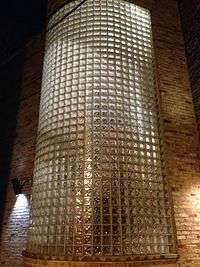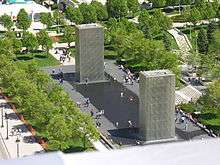Glass brick
Glass brick, also known as glass block, is an architectural element made from glass. Glass bricks provide visual obscuration while admitting light. The glass block was originally developed in the early 1900s to provide natural light in manufacturing plants.

Glass bricks are produced for both wall and floor applications. Glass blocks for use in floors are normally manufactured as a single solid piece, or as a hollow glass block with thicker side walls than the standard wall blocks. These blocks are normally cast into a reinforced concrete gridwork or set into a metal frame, allowing multiple units to be combined to span over openings in basements and roofs. Glass wall blocks should not be used in flooring applications. Hollow glass wall blocks are manufactured as two separate halves and, whilst the glass is still molten, the two pieces are pressed together and annealed. The resulting glass blocks will have a partial vacuum at the hollow centre.

Standards and grading
Glass blocks in Europe are manufactured in accordance with the European Standard EN1052-2. The International Standard is ISO TC 160/SG1. The Standards allow for variation in sizes and production irregularity. Blocks fall within three classifications; Class1, Class 2 and Class 3 with Class 1 being the highest and best rating with a maximum permissible deviation from designed size and rectangularity of 1 mm.
Construction methods
Glass wall blocks are fixed together to form complete walls by several methods – the most common method of construction is to bed the blocks together in a Portland cement-based mortar with reinforcing rods of steel placed within the mortar as recommended by the project architect or block manufacturer.
Other methods of construction include several proprietary systems whereby the mortar is replaced by timber or PVC extrusions.
R Value
Glass brick has an r value between 1.75 and 1.96, close to that of thermopane windows.[1][2] There are newer Glass Blocks injected with Argon gas and having a layer of low-emissivity glass between the halves, which increases the insulative (U) value to 1.5 W/m²·K, which is between triple glazed windows(1.8 W/m²·K) and specialty double glazed windows with advanced frame and coatings(1.2 W/m²·K).[3]
Specialty types
Specialist glass blocks are produced for various applications including:
Bullet and vandal resistance
Bullet and vandal resistant blocks are generally solid glass or have very thick side walls similar to pavement blocks.
Fire resistance
Fire resistance of varying degrees can be achieved by several methods. Standard production hollow wall block will offer little fire resistance; however, resistance is improved by utilising specially produced hollow blocks with thicker sidewalls, or the inclusion of a special layer of fire resisting material between the two halves of the block during manufacture. Some manufacturers of glass blocks have developed a method of bonding two glass blocks together with adhesive, producing blocks of up to 160 mm (6½") thick with enhanced fire resistance. It is important that the block manufacturer's recommendations are followed with regards to the installation of fire resisting glass block walls, as without special construction techniques, the wall will not achieve the desired fire resistance.
Gas insulated
A recent innovation in the manufacture of glass blocks is the inclusion of argon gas within the hollow centre of glass wall blocks. This advancement in production technique has resulted in a glass block which is able to offer significantly improved thermal insulation properties.
Colored
Some hollow glass wall blocks are available in coloured variants. These coloured variants fall into two categories; those that are manufactured with coloured glass which are UV stable and can be used in the same locations as standard clear glass blocks. The other method by which coloured glass blocks are achieved is to inject a coloured material, dye or transparent paint into the hollow centre of the blocks to form a permanent coating. This method of producing coloured blocks enables vibrant colours to be achieved which are not possible with coloured glass. The downside of this production method is that the coloured coating may not be UV stable and can fade in bright sunshine over time and may therefore, not be suitable for all locations.
Examples of architectural use
- Crown Fountain in Chicago, United States.
- Maison de Verre (for House of Glass) in Paris, France
- Michigan State Capitol in Lansing, Michigan
- Hermes Store in Ginza, Tokyo, Japan by Renzo Piano
- Streamline Moderne
 Crown Fountain is composed of glass brick towers.
Crown Fountain is composed of glass brick towers. Glass brick labyrinths, used to obscure clear visual line of sight into women's washroom on the left, and men's washroom on the right.
Glass brick labyrinths, used to obscure clear visual line of sight into women's washroom on the left, and men's washroom on the right. Glass block floor in the Michigan State Capitol
Glass block floor in the Michigan State Capitol
Maison de Verre
See also
References
- ↑ Archived November 27, 2013, at the Wayback Machine.
- ↑ "Glass Block Sales, Inc". Glassblocksales.com. Retrieved 2016-02-01.
- ↑ "Glass Block Q19 Energy Savings Technology Lines". Retrieved 2016-10-12.
External links
| Wikimedia Commons has media related to Glass blocks. |
- "Architects are Rediscovering Glass Block"—Masonry Magazine, 2003